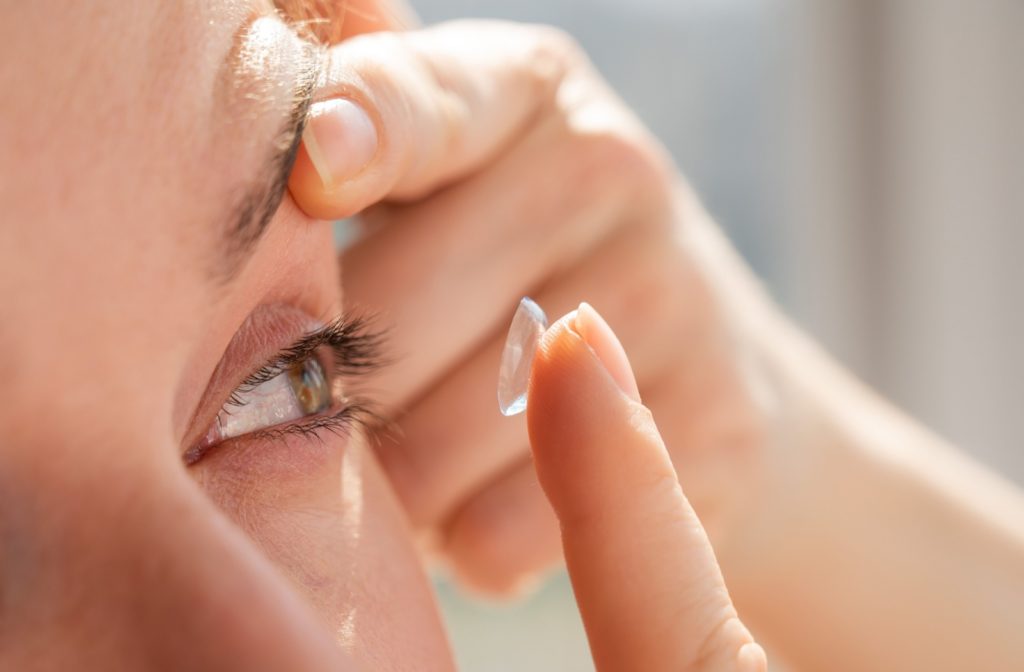Switching from eyeglasses to contact lenses is an exciting step for many. Freedom without frames, the expanded field of vision, and the ability to enjoy activities without worrying about fogging or slipping eyeglasses are just a few benefits of contact lenses.
As with any change, there’s an adjustment period. Adjusting to contact lenses may take a few days or weeks and depends on the individual and the type of contact lens. A contact lens exam is the first step in finding the right lenses for your preference and vision needs.
We walk you through what to expect as a new contact lens wearer, factors that affect the adjustment period, and some tips to make the transition smoother.
What Are Contact Lenses?
Contact lenses are small, thin discs made from various materials that sit directly on the eye’s surface or cornea. They work by correcting vision like eyeglasses do but with some significant differences.
Unlike eyeglasses, contacts move with your eye, providing a full field of vision without obstructions. Additionally, contact lenses don’t fog up in cold weather, get smudged or dirty like glasses can, and allow you to move freely without worrying about them slipping or breaking.
Adjustment Period for Contact Lenses
The direct placement of contact lenses on the eye means your body may need time to become accustomed to them. The adjustment period for contact lenses can vary from person to person and can take a few days to a couple of weeks to feel comfortable.
Factors That Affect the Adjustment Time
Several factors can influence how quickly you adapt to your contact lenses
Lens Type
You can get used to some contact lenses over others based on the type and material of the lens. Soft lenses are made of a flexible material that conforms to your eye’s shape, making them more comfortable and easier to adjust to.
Rigid gas permeable (RGP) lenses are more rigid, don’t mold as easily to the eye, and take longer to get used to. Multifocal or toric lenses are specialized contacts for presbyopia or astigmatism and may require longer adjustment times.
Individual Eye Sensitivity
It might take a little longer to adjust to contact lenses with dry or irritated eyes. Your eye doctor might recommend specific brands or lens types for sensitive eyes.
Initial Fitting Quality
A proper contact lens fitting during your first appointment is crucial. Poorly fitting lenses can cause discomfort and delays in the adjustment process.
Wear Schedule
Wearing contact lenses for the first time and all day may not let your eyes adjust gradually.
If you find the adjustment period is longer than expected, don’t hesitate to check in with your eye care provider. They may be able to offer solutions, like switching to a different lens material or using lubricating eye drops.

Tips for Easing the Adjustment Period
Adjusting to contact lenses doesn’t have to be difficult. Here are some tips to help you feel more comfortable as a new wearer:
- Start slow: Don’t wear your lenses all day in the beginning. Begin with a few hours a day and gradually increase the time as your eyes become more accustomed.
- Practice good contact lens hygiene: Always wash your hands before handling your lenses and follow your eye doctor’s instructions for proper cleaning and storage.
- Blink and stay hydrated: Blink more often while wearing contacts to help keep them lubricated. If you notice dryness, use doctor-recommended lubricating drops, and stay hydrated by drinking plenty of water.
- Take breaks: If your eyes feel tired or irritated, remove your lenses and switch to your eyeglasses for a break. Overdoing it can prolong the adjustment period.
- Follow up with your eye doctor: Regular check-ins with your eye doctor make sure your lenses are the right fit and prescription for your comfort and vision needs.
Signs of Trouble & When to Seek Help
It’s normal to feel a slight awareness of your lenses at first and some mild discomfort as your eyes adapt. However, if you notice any of the following signs of an eye issue, it’s important to contact your eye doctor:
- Persistent pain or discomfort
- Redness or swelling
- Blurry vision that doesn’t improve
- Sensitivity to light
- Excessive dryness
- Watery eyes
- Discharge
These may indicate underlying issues like an ill-fitting lens, an allergic reaction, or an eye infection that needs immediate attention.
Contact Lens Vision Correction & Comfort
Adjusting to contact lenses is a process, but in the end, they provide vision correction and comfort. Most people feel fully comfortable within a few weeks and enjoy the benefits of crisp vision without the hassle of glasses.
If you’re considering making the switch or experiencing any challenges, book an appointment with Total Vision Tierrasanta. Our eye doctors can provide personalized advice and help make your transition as smooth as possible.


